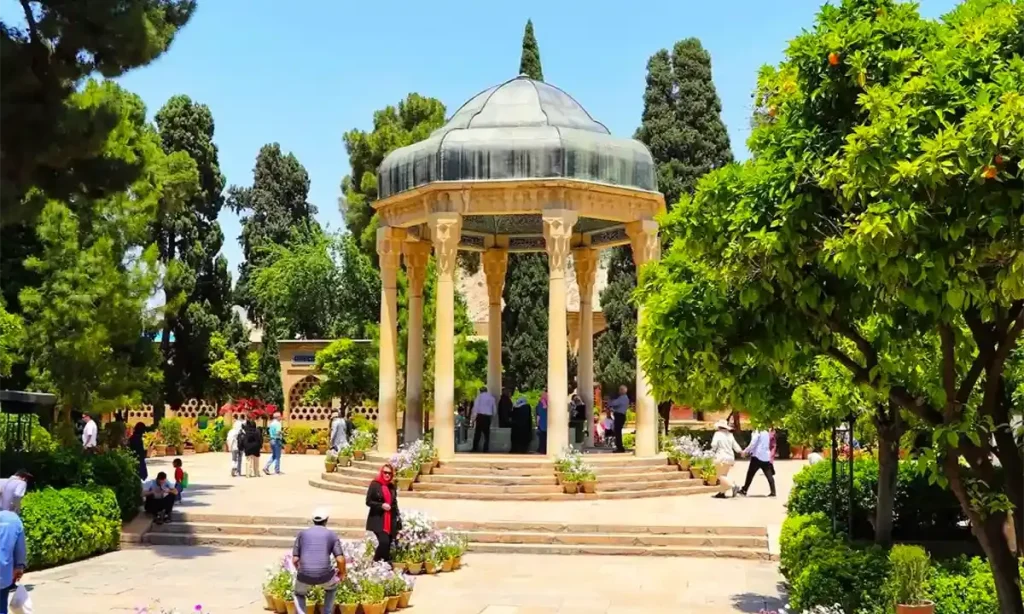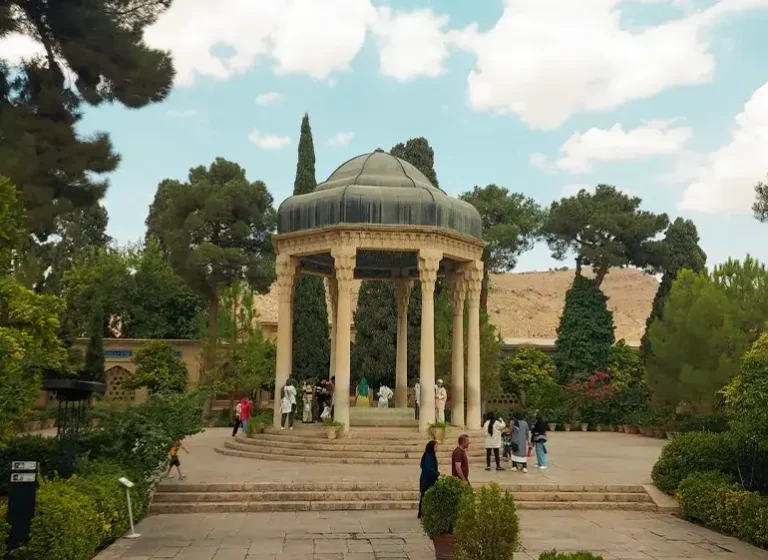Lead: Iran, a country celebrated for its distinct four-season climate, boasts a remarkable geographical diversity shaped by its extensive latitudes and longitudes. From semi-desert mountainous regions to lush fertile plains, the high plateau of Iran offers travelers a rich tapestry of climatic and scenic variety. If you’re planning a journey to this culturally rich land, familiarizing yourself with its top destinations is essential. This guide will introduce you to the famed spots that enchant tourists year after year. Dive into our comprehensive exploration of the best places to visit in Iran, and prepare for an unforgettable travel experience in 2024.
What are the best places to visit in Iran that you should know (2024)?
- Tehran
- Shiraz
- Isfahan
- Kashan
- Tabriz
- Yazd
- Qom
- Kerman
- Mashhad
- Kermanshah
Tehran, the capital city of Iran
As the bustling capital of Iran, Tehran is a city where history meets modernity, offering an array of unforgettable experiences. Whether you’re seeking the serenity of nature or the intrigue of historical sites, Tehran promises a tapestry of attractions that cater to all tastes.
For those drawn to the outdoors, the city’s numerous parks and natural spots provide a peaceful retreat amidst the urban hustle. Spend an evening strolling through the expansive Laleh Park, or enjoy a late-night picnic under the stars at Ab-o-Atash Park.
If cultural and historical exploration is more your style, Tehran will not disappoint. The city is dotted with an impressive collection of palaces, museums, and mansions, each telling stories of Iran’s rich heritage and intricate past. Here are some of Tehran’s must-visit sites:
- Golestan Palace: A masterpiece of the Qajar era, this palace complex is one of Tehran’s oldest historic monuments and is a UNESCO World Heritage Site, celebrated for its ornate rooms and lavish gardens.
- National Jewelry Museum: Home to one of the world’s most significant jewelry collections, this museum displays an array of gems and jewels, including the famous Darya-e Noor diamond.
- Niavaran Palace Complex: Situated in the northern part of Tehran, this complex serves as a cultural-historical hub that features several palaces, museums, and beautifully landscaped gardens.
- Tehran Museum of Contemporary Art: Known for its outstanding collection of post-19th-century artwork, including both Western and Iranian artists.
- Tajrish Bazaar A market of Tehran’s sights: Tajrish Bazaar is one of the oldest shopping centers in Shemiran and still retains its old texture so that the famous and old rooms of the bazaar have not lost their identity. This bazaar, which is a small example of Tehran Bazaar, has been built indoors and it connects the Sarpol and Tajrish neighborhoods. To enjoy all the best places in this country, you can use a car rental in Iran. This can help you to visit all the best places in this country.
- Nature Bridge A bridge from the sights of Tehran: Nature Bridge, which is one of the symbols of Tehran and one of the best sights of Tehran. It crosses the Modares Highway and connects Taleghani Parks in the east and Water and Fire in the west. Along the bridge, spaces with cultural, recreational, and tourism functions have been prepared, such as a coffee shop, restaurant, and gallery cafe, as well as the green space worked on the bridge, which provides a beautiful view along with the curvature of the body.
- Milad Tower of Tehran is one of the best sights in Tehran: Milad Tower is the tallest skyscraper in Iran and the sixth tallest telecommunication tower in the world. This multi-purpose telecommunication tower is located in the complex of Tehran International Communication Center, in the northwest of Tehran, between a hill with an approximate area of 14 hectares, located in the south of Qods city and north of Koi Nasr in region 2 of Tehran municipality. The structure of Milad Tower is visible from almost everywhere in Tehran due to its high height and different appearance.
Each of these places offers a unique glimpse into the diverse cultural fabric of Tehran, making them essential stops on your visit to this dynamic city.
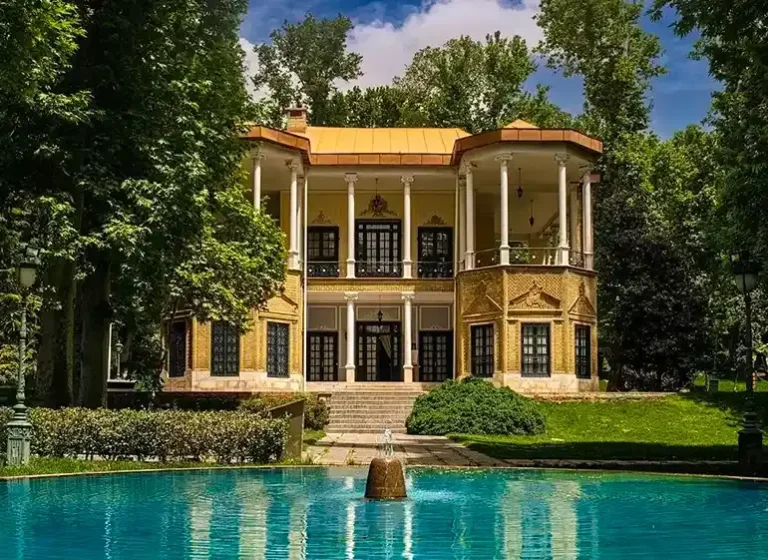
Shiraz, one of the best cities in Iran
Shiraz, the provincial capital of Fars, is one of Iran’s most enchanting metropolises. Renowned for its deep historical roots and as a center for Persian culture and literature, Shiraz is often referred to as the city of poets, literature, and gardens. Though it no longer produces wine, the city’s legacy as a wine producer before the Islamic Revolution adds to its rich historical tapestry.
The city is especially captivating due to its lush orchards and abundant fruit trees, weaving a fabric of greenery through the urban landscape. For a convenient and flexible way to explore Shiraz, consider renting a car, which allows you to visit the best spots at your own pace.
Here are some must-visit attractions in Shiraz:
- Nasir al-Mulk Mosque: Also known as the Pink Mosque, it is famous for its dazzling stained glass windows that create a kaleidoscope of colors when sunlight streams through.
- Eram Garden: A historic Persian garden that exemplifies the classical Persian garden design, with flowing water, towering cypresses, and fragrant flowers.
- Tomb of Hafez: A memorial to the celebrated Persian poet Hafez, set within a beautiful garden that invites contemplation and offers a glimpse into the poetic soul of Shiraz.
- Vakil Bazaar: A traditional market where you can experience the vibrant atmosphere and purchase local crafts, spices, and herbs.
- Saadieh: Saadieh is the name of one of the sights of Shiraz where Saadi’s tomb is located. Saadi is one of the most popular and famous poets of the seventh century AH, whose tomb is now visited by many travelers and tourists.
- National Garden: You can find the oldest and tallest trees in Shiraz in its national garden. This garden, which is located in front of Hafez’s tomb, is very beautiful and is one of the oldest gardens in Shiraz. National Garden or National Park is one of the tourist places of Shiraz and is a unique choice for fun and relaxation.
Each of these sites not only showcases the beauty and historical depth of Shiraz but also offers a unique insight into the cultural fabric of this storied city.
Best places in Isfahan
Isfahan, often described as “Half the World” due to its profound cultural importance and beauty, is a city where the richness of Iranian art and taste is vividly on display. Its splendor is mirrored in every corner, from the majestic architecture to the intricate details of its handicrafts.
As you wander through Isfahan, you can lose yourself in the endless blue of its intricately tiled mosques and cool your gaze in the vibrant gardens that paint the cityscape. Each tile and garden tells a story, weaving a tapestry of beauty that invites visitors to dream.
The city is not just a place; it’s an experience, where every archway and garden pathway offers a passage through time. In Isfahan, you can create your legends, live through the narratives embedded in the stones of its grand palaces, and imagine life as it was in the lush courtyards of its dream-like estates.
Explore Isfahan and live within the masterpiece of Persian art and architecture, an everlasting tribute to the sophistication and vision of its creators.
Some places in this city are:
- Naqsh-e Jahan Square (Imam Square): One of the largest city squares in the world, surrounded by monumental buildings such as the Ali Qapu Palace, Sheikh Lotfollah Mosque, and the Imam Mosque. The square is also home to the Isfahan Grand Bazaar, where you can explore traditional handicrafts and sample local cuisine.
- Si-o-se-pol Bridge: An iconic example of Safavid bridge design, this structure features 33 arches and is the largest of the eleven historical bridges over the Zayandeh River. It’s especially beautiful at sunset or in the evening when the lights reflect on the water.
- Chehel Sotoun Palace: A palace set in a beautiful garden, known for its 20 wooden columns that reflect in the front pool, giving the illusion of 40 columns. The palace’s interior is adorned with stunning frescoes and paintings depicting historical scenes.
- Jameh Mosque of Isfahan: One of the oldest mosques in Iran, it covers more than 20,000 square meters and features a stunning collection of architectural styles accumulated over 1,200 years, making it a veritable museum of Islamic architecture and art.
- Vank Cathedral: Located in the Armenian quarter of Jolfa, this cathedral is notable for its blending of Islamic and Christian architecture styles. Its interior is richly decorated with frescoes, gold paint, and tiles depicting biblical scenes.
- Khaju Bridge: Another famous bridge in Isfahan, known for its architectural beauty and dual-purpose design. It serves both as a bridge and a dam and has a central pavilion that was once used by the Shah for entertainment.
- Shah Mosque (Imam Mosque): Known for its stunning Safavid Islamic architecture, the mosque is an exquisite example of Iranian craftsmanship. The mosque’s dome is one of the most magnificent in Iran, echoing sounds across the large, open square.
Each of these places not only showcases the beauty and historical depth of Isfahan but also offers a unique insight into the cultural fabric of this historic city.
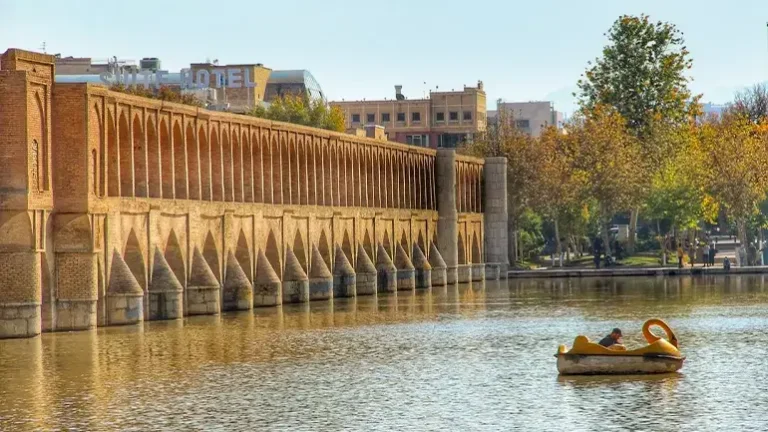
Kashan city
Kashan is not just a city but a living museum of fragrant gardens, historical architecture, and enduring traditions. Renowned for its captivating beauty and ancient heritage, Kashan is a place where history resonates through the narrow lanes of its bazaars and the elegant courtyards of its traditional houses.
This city is an oasis of tranquility, particularly in its historical homes that offer refuge from the summer heat with their ingenious windcatchers and lush courtyards. Each corner of Kashan invites visitors to immerse themselves in a rich tapestry of experiences, from exploring its well-preserved architectural marvels to participating in age-old rituals.
Kashan’s multifaceted attractions include:
- Fin Garden: A masterpiece of Persian landscape design and also one of the oldest surviving gardens in Iran, encapsulating the essence of Persian garden layout.
- Tabatabaei House: A stunning example of Persian residential architecture, featuring intricate stucco, spectacular mirror work, and classic stained glass.
- Agha Bozorg Mosque: Known for its symmetrical design and imposing dome, this mosque and madrasa complex is a center of spiritual learning and a striking example of Islamic architecture.
- Sultan Amir Ahmad Bathhouse: A historic bathhouse whose interiors are adorned with turquoise and gold tilework, creating a dazzling display of color and artistry.
- Mirahmad Kashan Bath: This bath belongs to the Seljuk era. The reason for naming the bath is that it is adjacent to the Imamzadeh of Sultan Amir Ahmad. Of course, the current building of the bath is something that was renovated during the Qajar period. Mir Ahmad Bath has two baths, one small and the other large. Bath customers mostly went to the bathroom on weekends. Bathroom plasters have 17 layers of restoration. The dome-shaped roof of the bathroom is one of the most beautiful dome-shaped roofs in our country due to its stunning beauty.
Kashan’s enchanting atmosphere is further enriched by its array of natural and cultural sights, making it a quintessential stop for those seeking to explore the depths of Iran’s historical and cultural landscapes.
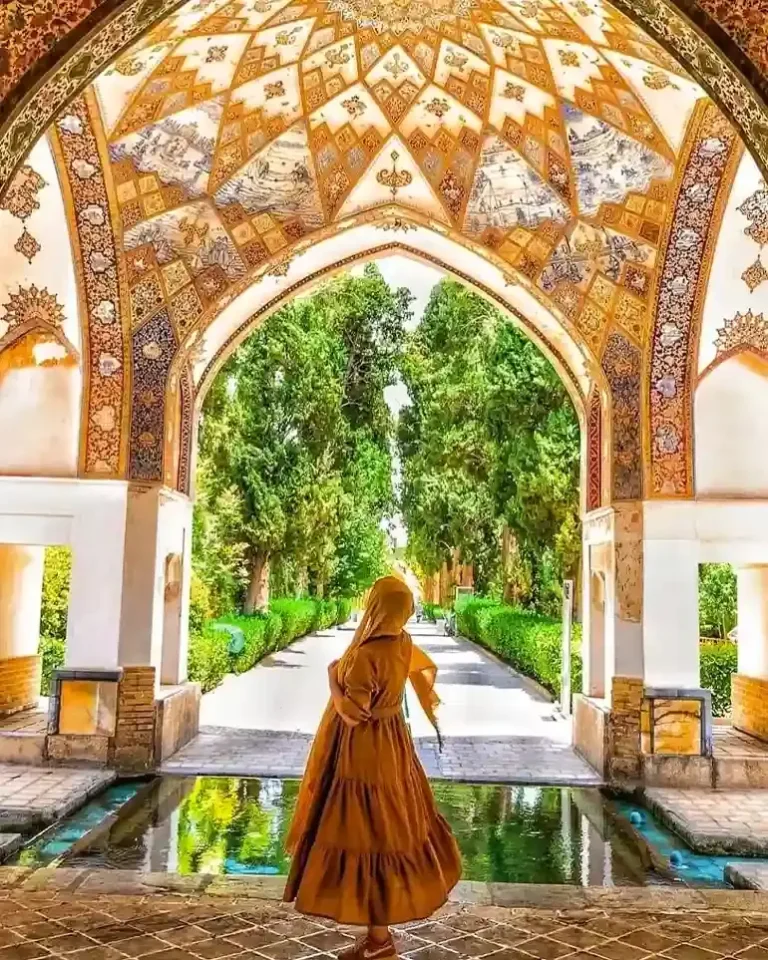
Tabriz: A Journey Through Iran’s Cultural Crossroads
Tabriz, located in the northwest of Iran, is one of the country’s historical capitals and a significant hub of cultural heritage, commerce, and crafts. This city is famed for its rich history, vibrant bazaars, and a unique blend of cultures that have shaped its development over the centuries. Here’s a closer look at what makes Tabriz a must-visit destination:
- Tabriz Historic Bazaar Complex: A UNESCO World Heritage site, this bazaar is one of the oldest and largest in the Middle East. The bazaar is a sprawling maze of interconnected covered passages that house a variety of artisans and traders selling everything from spices and jewelry to Persian rugs. The structure of the bazaar offers insights into the socio-economic growth of the city throughout history.
- Blue Mosque (Masjed-e Kabud): Dating back to the 15th century, this mosque was once adorned with exquisite blue tiles and intricate calligraphy, earning it the nickname “The Turquoise of Islam.” Although damaged significantly by an earthquake in the late 18th century, its partial restoration allows visitors to glimpse its former glory.
- El Goli (Shah Goli): A large historic park centered around an artificial lake, El Goli is a popular recreational spot for locals and tourists alike. It features a grand mansion in the middle of the lake, originally used as a royal summer residence.
Azerbaijan Museum: As one of the most important museums in Iran, it houses a vast collection of artifacts that trace the history of the region. The museum includes items from pre-Islamic and Islamic periods, showcasing ceramics, sculptures, and historical coins. - Constitution House of Tabriz: This museum is dedicated to the history of the Constitutional Revolution of Iran, which began in the early 20th century. The house itself played a significant role in the movements of that era and features well-preserved interiors and historical documents.
- Saint Mary Church (Qara Kelisa): Also known as St. Thaddeus Church, this ancient Armenian church is located near Tabriz and is considered one of the oldest churches in the world, showcasing the religious diversity of the region.
- Kandovan Village: Just outside Tabriz, this remarkable village is known for its homes carved into volcanic rocks, similar to those in Cappadocia, Turkey. The residents still live in these cave dwellings, some of which are over 700 years old.
Tabriz is not only a gateway to exploring the rich tapestry of Iran’s Azari culture but also serves as a testament to the resilience and artistic achievements of its people. Whether you’re exploring its bustling bazaars or enjoying its beautiful parks and historic sites, Tabriz offers a unique and enriching experience for every visitor.
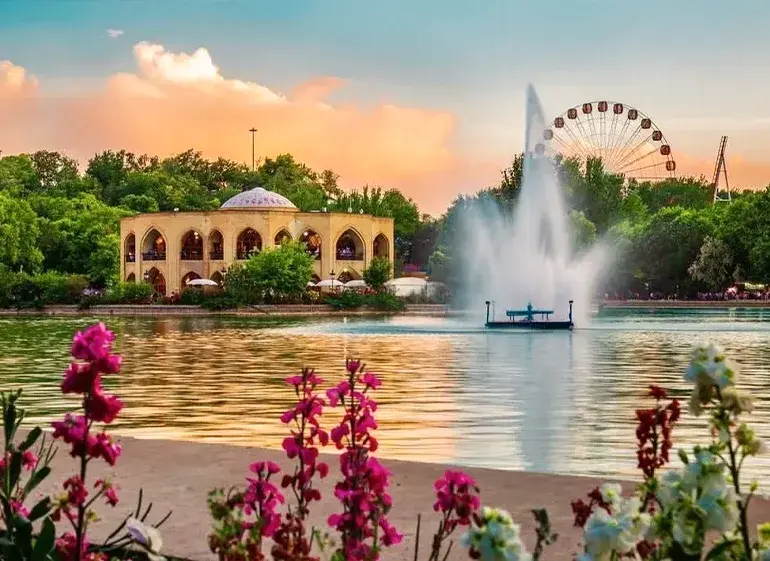
Yazd: The Timeless Desert City of Windcatchers
Yazd, often referred to as the “City of Windcatchers,” is an enchanting destination nestled in the heart of Iran’s desert. This ancient city is renowned for its unique adobe architecture, designed to adapt to the harsh desert climate, and for preserving many aspects of traditional Persian culture. Here’s an overview of what makes Yazd a fascinating place to visit:
- The Historic City of Yazd: Recognized as a UNESCO World Heritage Site, Yazd is one of the oldest continuously inhabited cities in the world. Its urban fabric is made up of narrow lanes and traditional houses with tall windcatchers (badgirs), which are ancient architectural devices used to create natural ventilation in buildings.
- Amir Chakhmaq Complex: This iconic landmark of Yazd features a stunning three-story facade, beautifully lit after sunset. It includes a mosque, a caravanserai, a bathhouse, a cold water well, and a confectionery. The symmetrical architecture and imposing size make it a focal point in the cityscape.
- Zoroastrian Fire Temple: Yazd is an important center for the Zoroastrian community in Iran. The Fire Temple, Atash Behram, houses a flame that has been burning continuously since 470 AD, symbolizing the community’s enduring presence in the region.
- Dowlat Abad Garden: Famous for having one of the tallest windcatchers in Iran, this well-preserved Persian garden reflects ancient landscaping principles that harmonize water and greenery in the middle of the desert, offering a tranquil escape from the surrounding arid landscape.
- Jameh Mosque of Yazd: With its impressive entrance portal, decorated with dazzling tile work primarily in blue, the mosque is a fine specimen of the Azari style of Persian architecture. The mosque also features one of the tallest minarets among Persian mosques.
- Yazd Bazaar: A visit to the bazaar is essential to experience the local culture. Here, you can find everything from spices and silk fabrics to handicrafts like copperware and jewelry.
- Kharanaq, Chak Chak, and Meybod: Day trips from Yazd can take you to these ancient villages and sites, where you can see an abandoned mud-brick village, an ancient Zoroastrian pilgrimage site, and a historic desert castle, respectively.
Yazd’s architecture and city planning superbly illustrate the adaptation of human settlements to desert environments, making it a testament to the ingenuity of its inhabitants and an essential stop for anyone interested in Persian history and architecture.
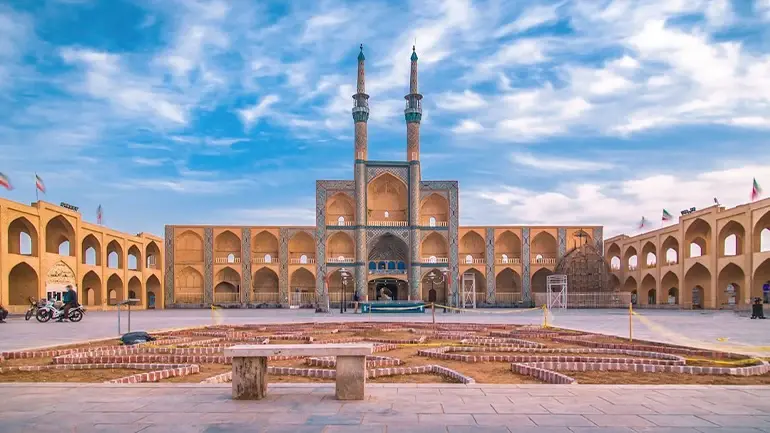
Mashhad, Spiritual Splendor at the Heart of Iran
Mashhad, the second-largest city in Iran, is a deeply spiritual place renowned primarily for its religious significance. It is located in the northeast of the country, serving as the capital of Khorasan Razavi Province. Here’s what makes Mashhad a remarkable destination:
- Imam Reza Shrine: This is the centerpiece of Mashhad and one of the most important religious sites in Iran. The shrine complex is massive, including the mausoleum of Imam Reza, the eighth Shia Imam. Millions of pilgrims visit this site annually, drawn by its spiritual significance and architectural beauty. The complex also features a museum, a library, four seminaries, a cemetery, the Razavi University of Islamic Sciences, a dining hall for pilgrims, vast prayer halls, and other buildings.
- Goharshad Mosque: Attached to the Imam Reza shrine, this mosque is a masterpiece of Persian architecture built by the order of Goharshad Begum, wife of Shah Rukh of the Timurid dynasty, in the 15th century. Its intricate tile work and grand size are particularly impressive.
- Tomb of Nader Shah: Dedicated to one of Iran’s most powerful rulers, the Nader Shah Mausoleum features a modern architectural style and houses a museum showcasing weapons, manuscripts, and various historical artifacts related to Nader Shah’s reign.
- Ferdowsi’s Tomb: Located in the nearby town of Tus, this mausoleum is dedicated to the famous Persian poet Ferdowsi, known for his epic work, the Shahnameh, which is crucial to Persian literature. The site is a cultural beacon and a beautifully landscaped complex that attracts many literature enthusiasts.
- Kooh Sangi Park: One of the oldest parks in Mashhad, Kooh Sangi serves as a popular local gathering spot. Positioned between two mountain rocks, it offers pleasant walking paths, picnic areas, and beautiful views of the city.
- Bazaar Reza: Known for its vibrant atmosphere, this bazaar is a great place to experience local life. Visitors can buy religious souvenirs, traditional Iranian sweets like saffron sugar crystals, and turquoise gemstones.
- Museum of Imam Reza: This museum, within the Imam Reza shrine complex, holds various artifacts related to the history of Islam and the Imam himself, including exquisite Qurans, fine carpets, and ancient coins.
Mashhad’s blend of spiritual sanctity and rich Persian culture makes it a unique city that offers both a deep dive into Iran’s religious heart and a broader cultural experience.
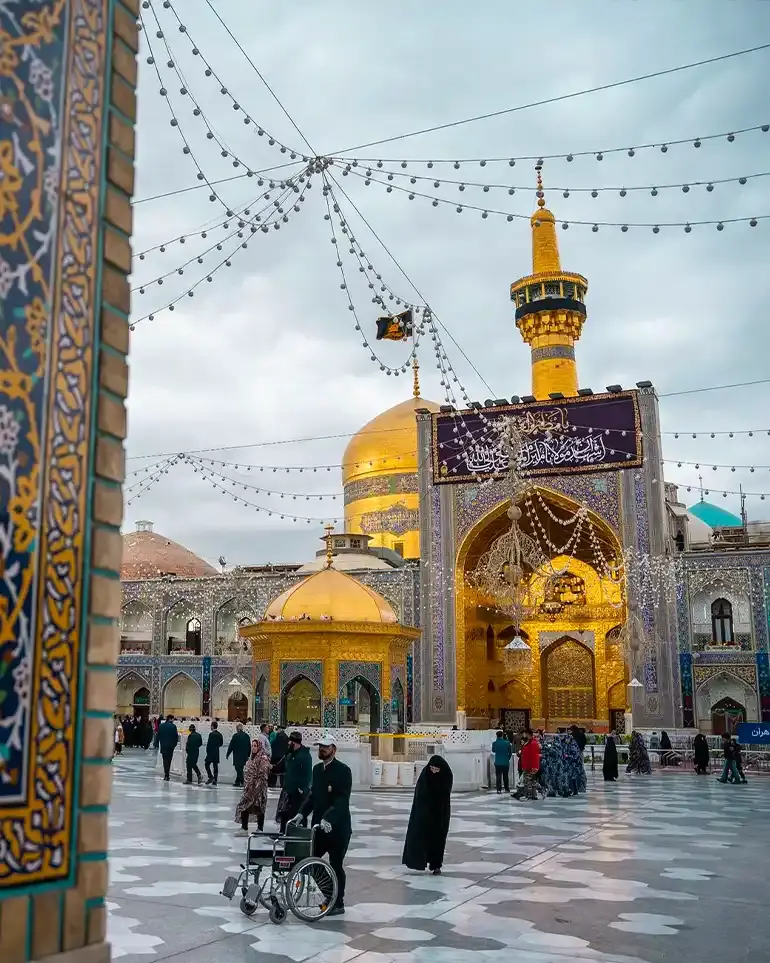
Kerman: Cultural Oasis in Iran's Desert Landscape
Kerman, situated in southeastern Iran, is a historic city known for its strong cultural heritage, impressive architecture, and being a gateway to some of Iran’s most remarkable deserts. Here’s a deeper look at what makes Kerman a must-visit destination:
- Ganjali Khan Complex: At the heart of Kerman’s bazaar, this 17th-century complex is an architectural marvel that includes a mosque, a caravanserai, a bathhouse, and a square. The bathhouse, in particular, has been converted into an ethnography museum that showcases traditional local lifestyles.
- Kerman Grand Bazaar: With its origins dating back to the 14th century, this bazaar is one of the oldest trading centers in Iran. It’s known for its vibrant collection of handmade carpets, pistachios, copper handicrafts, and traditional textiles.
- Mahan: A short drive from Kerman, Mahan is famous for the Shazdeh Garden (Prince’s Garden), a fine example of Persian gardens that bring a lush, green oasis to the desert landscape. The nearby Tomb of Shah Nematollah Vali, the renowned Sufi Dervish, is also worth visiting.
- Rayen Castle: Comparable to the famous Bam Citadel but less crowded, Rayen Castle is a well-preserved adobe fortress that dates back to the Sassanian era. It offers visitors a glimpse into the historical lifestyle of the region.
- Kaluts (Shahdad Desert): The desert area near Kerman is known for its kaluts, naturally formed sandy rock formations that create an almost Martian landscape. This part of the Lut Desert has been recorded as one of the hottest places on Earth and is a striking natural wonder.
- Jabalieh Dome: Also known as the Rock Dome, this is an ancient stone building in Kerman, believed to date back to the Sassanian period. The structure’s architectural style and purpose remain debatable, but it currently serves as a museum of stone inscriptions.
- Fathabad Garden: Located on the outskirts of Kerman, this garden is inspired by the famous gardens of Esfahan and was built during the Qajar era. It’s a beautiful example of Persian garden design, featuring a central pavilion surrounded by water channels and lush greenery.
Kerman’s blend of natural beauty, historical sites, and its status as a cultural crossroads make it a fascinating destination for those interested in history, architecture, and nature.
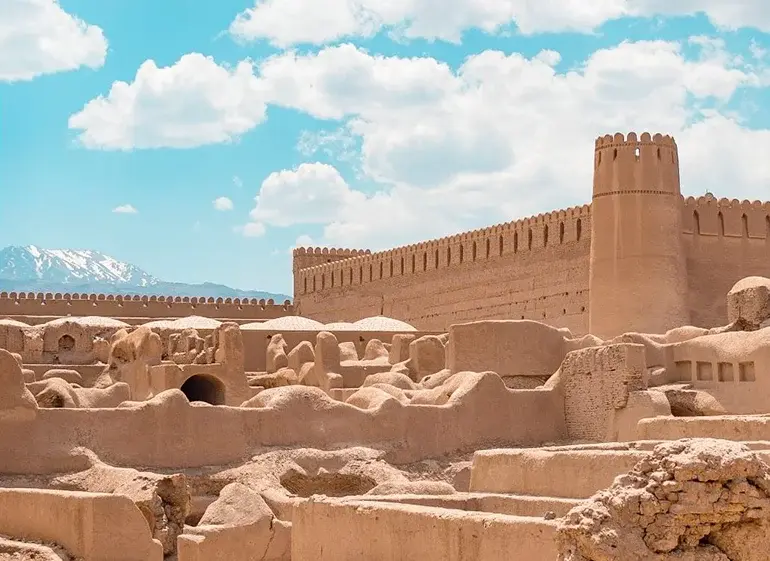
Qom, Spiritual Sanctuary in the Heart of Iran
Qom, situated just south of Tehran, is one of the holiest cities in Iran and a significant center for Shia Islam. It’s renowned for its spiritual atmosphere, religious schools, and historic sites. Here are the key highlights that make Qom an important destination for both pilgrims and tourists:
- Fatima Masumeh Shrine: The heart of Qom is the shrine of Fatima Masumeh, the sister of Imam Reza, the eighth Shia Imam. This magnificent complex is adorned with spectacular golden domes and intricate tile work. It is one of the most significant pilgrimage sites in Iran, drawing thousands of Shi’a Muslims annually.
- Jamkaran Mosque: Located on the outskirts of the city, this mosque is associated with the Mahdi, the Twelfth Imam, whom Shi’a Muslims believe will return as a savior. It’s a place of great spiritual significance, especially on Tuesday evenings when it attracts pilgrims from across the country.
- Qom Bazaar: This traditional bazaar is a bustling hub where visitors can explore an array of religious souvenirs, Persian carpets, jewelry, and seminary books. The bazaar is also a good place to sample local cuisine, including sohan, a saffron-flavored Persian brittle.
- The Seminary of Qom (Hawza Ilmiyya): This is one of the largest theological colleges in the Islamic world. While not typically open to tourists, its presence significantly influences the city’s culture and scholarly pursuits.
- Astane Square: As the main square in Qom, this area is bustling with activity and is surrounded by numerous shops and eateries. It provides a glimpse into the daily lives of the city’s residents.
- Green Dome Tomb: This site is dedicated to Sahl ibn Ali, an early Muslim who was one of the companions of the Prophet Muhammad. The dome’s vibrant green color makes it a picturesque landmark in Qom.
- Boo Ali Sina (Avicenna) Park: This large park offers a quiet escape from the city’s bustling environment. It’s ideal for an evening walk or a relaxing family picnic.
Qom’s blend of spiritual significance and cultural heritage makes it a unique city, offering insights into the religious and historical roots of Iran. Whether you are a pilgrim or a traveler seeking to understand the depth of Shia Islam, Qom provides a profound and enriching experience.
Kermanshah: Echoes of Antiquity in Western Iran
Kermanshah, located in western Iran, is a city steeped in history and rich in cultural heritage. It is known for its significant archaeological sites, ancient inscriptions, and beautiful landscapes. Kermanshah’s history dates back to ancient times, and it has been an important city for various civilizations, including the Medes, Persians, and Parthians. Here are some of the most notable attractions and aspects of Kermanshah that make it a fascinating destination:
- Bisotun: This UNESCO World Heritage site is famous for its bas-relief and cuneiform inscription created during the reign of Darius I, the Great, of the Achaemenid Empire. The relief depicts Darius holding a bow, symbolizing his sovereignty, as he stands before a row of defeated rebel leaders. The site is crucial for the study of the Persian Empire and the history of writing.
- Taq-e Bostan: These series of large rock reliefs from the era of the Sassanian Empire, located in a park at the base of a mountain, illustrate the imperial ceremonies and royal hunts of Sassanian kings. The site is also famous for its exquisite bas-reliefs depicting royal figures and scenes of hunting and festivities.
- The Temple of Anahita: Located at Kangavar, on the way to Kermanshah, this site is believed to have been dedicated to Anahita, the goddess of water and fertility. The remains of this massive temple complex reflect the architectural influence of both Greek and Persian cultures.
- Zagros Paleolithic Museum: This museum in Kermanshah is one of the few museums in the world dedicated exclusively to Paleolithic artifacts. It houses an extensive collection of tools and fossils that were discovered in the Zagros mountain range, providing insights into early human life.
- Biglar Beigi Tekyeh: This historical building is notable for its unique architecture and serves as a place for traditional Shia mourning rituals. Its intricate tile work and grand architecture are indicative of the cultural richness of the area.
- Kermanshah Bazaar: A traditional bazaar that showcases the local life, culture, and products of the region. Visitors can find handicrafts such as leather goods, traditional footwear, and local sweets like baklava and nan-e berenji.
- Shafei Mosque: This mosque, which is located in the city center, is another excellent example of Islamic architecture with its beautiful decoration and large prayer hall.
Kermanshah’s blend of historical depth, cultural diversity, and natural beauty make it an essential stop for those interested in exploring the ancient heritage and scenic landscapes of Iran.
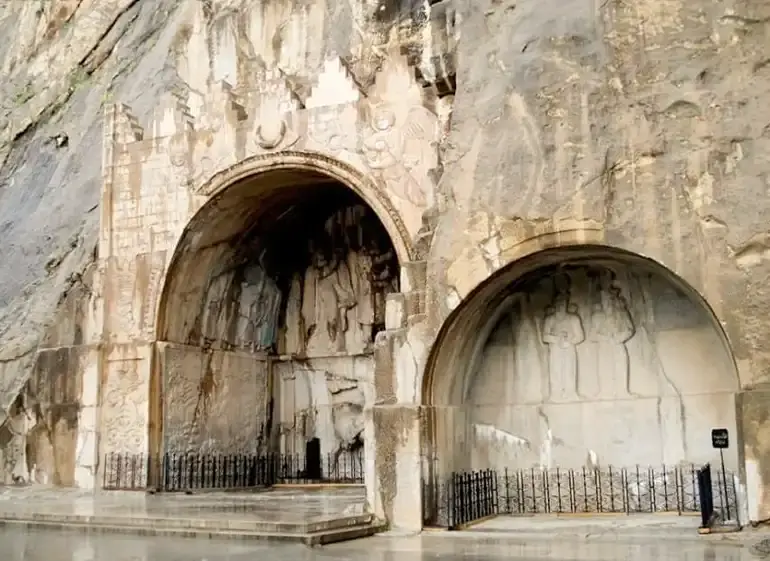
Last word
In 2024, Iran continues to stand as a testament to the enduring allure of ancient civilizations blended seamlessly with vibrant modern culture. From the bustling markets of Tehran to the historic ruins of Persepolis, and from the poetic city of Shiraz to the spiritual tranquility of Mashhad, each destination in Iran offers its own unique story and an unforgettable experience. The country’s rich tapestry of landscapes—from stark deserts to lush mountain slopes—mirrors its cultural diversity, making it a compelling destination for adventurers, scholars, and those in search of spiritual reflection alike. As you plan your travels for the coming year, consider Iran not just as a place to visit, but as a journey through history, art, and human connection. Venture beyond the familiar and embrace the extraordinary in Iran—the heart of the ancient world, where every corner holds a new discovery waiting to be explored.
FAQ
The best times to visit Iran are during the spring months of March to May and the autumn months of September to early November. During these periods, the weather is generally mild and pleasant across the country, making it ideal for sightseeing and outdoor activities.
Whether you need a visa to visit Iran depends on your nationality. Consider using a reputable travel agency familiar with Iranian visa procedures to assist you, particularly if you’re required to have a guided tour.
Iran is generally safe for tourists, with a low rate of violent crime and a population known for its hospitality towards visitors. However, as with any travel destination, it’s important to stay informed of the local laws and customs, respect cultural norms, and stay updated with travel advisories from your home country.
